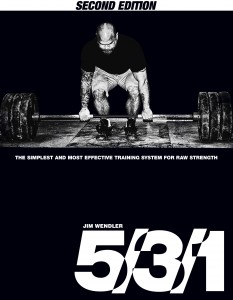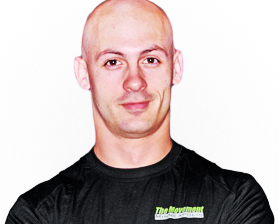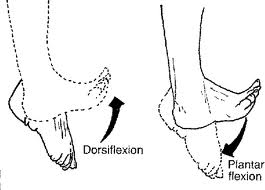
The following tutorial is a an explanation by Tucson fitness trainer Eric Frey. Eric owns and operates Quality Strength in Tucson. This post was originally shared as a reply to a question in my public Biofeedback Training group about how to use biofeedback with 5/3/1. The answer was so good that I wanted to archive it here for people who are curious about how to use a program like 5/3/1 but integrate biofeedback. I’ve edited it for clarity and legibility as an article, but all the ideas are his.

Wendler says that the goal should be to set rep records on the main lift every workout. This is in line with the goal of setting a PR every day, but it may be too specific for what your body wants to do on a given day. So first off, I throw that imperative out the window.
Let’s assume your main lift tested well. Even on the third wave your first two sets, which should be submaximal are only 75% for 5 and 85% for 3. Keep in mind that these are percentages of a training max, and not a true 1 rep max. Training max should always be 90% (sometimes it will be less than) of your 1RM. So, these sets, on most days, are still not going to be very hard. I find they serve very well as work up sets. Again, all of this is assuming your main lift tested well, which I test while warming up. I do test after each warm up set and those first two sets to see if there’s a reason to stop. For me, if the lift tests well, the weight usually isn’t the deal-breaker. If for some reason, I have to stop increasing the load, then I do and just work with what tested well for the main lift. (ddn note: this is a key point – you may not be able to hit your “target” weight, but you can often get more volume in at a lower intensity – and still set a volume PR for that weight.)
The max set of main lifts in waves 1-3 are all just that, undefined “max” sets. Here is where I focus on the elements of effort and use those to tell me when to stop. I find that works exceedingly well.
If the main lift doesn’t test well, I test variations or if no macro variations work well then I might try to break it up into smaller pieces or components of the lifts. I’ll work up to a good set of five, or a triple and move on. Close enough is good enough.
When planning my next cycle, if I find I’ve done well then I’ll increase the training maxes by small increments, as Wendler recommends, and keep pushing. If I find that I’ve had to make a lot of substitutions, then I will plan my next cycle to accommodate that. Usually, however, I try to make the changes in the assistance work, since I’m often using 5/3/1 to prep for a meet, and so I don’t want to deviate too far from the basic 4 lifts.
The assistance work is where you can be really flexible and rock the heck out of the biofeedback. I figure as long as I’m getting about 50-100 reps total of assistance work choosing exercises and loads by testing, then I’m ok. I try not to overthink it too much. I do less volume the closer I get to a meet. Wendler 5/3/1’s is fairly saggital plane dominant, so the assistance work is where I really try to squeeze in things that I know are lacking in my daily activities and transverse plane stuff.
There are days when the main lift and a few variations don’t test well. Let’s say this lands on squat day, I’ll take it to mean I ought not do squats today, and I’ll bail on that workout. If I think I can re-arrange the week, say flip squat and bench day, then I’ll see if that tests well. If I don’t think I can do that, I’ll do some stretching, rolling, mobility, tai chi, or what not, and try again tomorrow.
Early on in my playing around with biofeedback I had this one workout. Main lift didn’t test well. Variations didn’t test well. It was a squat day. Tried deadlifts, didn’t test well. Bench and push-up variations, didn’t test well. Rows and chin ups? Nope. I spent a half hour testing things to see what I could do. Nothing tested well and I felt like crap the next day. Since learning that lesson, if things don’t test well I don’t push it. I just do some active rest and pick up the next day.
Again, this is what works for me. Keeping the training max low is important in the main lifts. Hope that helps.
ddn’s note: Wendler’s 5/3/1 is a tried-and-true time-tested programming template for strength and muscular development. That said, I’ve known enough people who have been frustrated with their 5/3/1 results to know that it leaves something to be desired in terms of results for some people. It’s my experience that these folks are following the program too rigidly and not taking advantage of times when they could do more than what is called for while simultaneously forcing it when they should be doing a little less than what is programmed. Using biofeedback to bespoke this template gives you the best of both worlds – a proven paradigm for progressive strength training, and a way to customize it to make it work even better for you.


